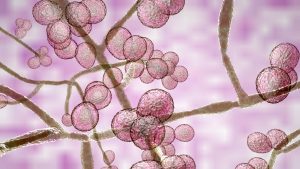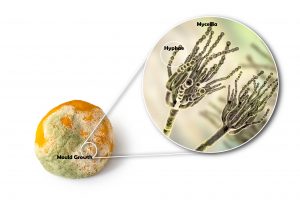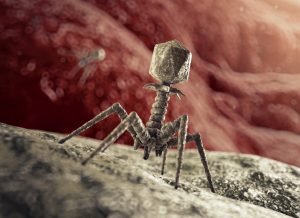Unit 1a. Overview of Dairy Microbiology and Fermentations; The basics
What are microbes?
A microbe, or a microorganism, is a microscopic organism formed by either a single cell (unicellular), cell clusters, or many cells (multi-cellular). They are too small to be seen by the naked eye but are complex organisms. They are seen with the help of a microscope and are studied by the science of microbiology.
Microorganisms can be prokaryotes such as bacteria and cyanobacteria, eukaryotes such as fungi and protozoa, and acellular microorganisms like viruses that lack the characteristics of living things, except the ability to replicate, which they do only when they invade a cell.
Microbes can live wherever there is accessible liquid water. In foods, the main microorganisms of concern (for the good and the bad) are bacteria, yeasts and moulds. They differ in size, structure and metabolic capacities.
The following diagram compares the size of different microorganisms. Scroll left to right to compare different microorganisms.
Figure 1a.1. The size of microorganisms.
Bacteria
They’re everywhere, Ubiquitous! The right types are useful in many food products but the wrong types are dangerous in foods
Video 1a.1. Bacteria 101.
Yeasts
This type of fungus includes multicellular filamentous moulds, macroscopic filamentous fungi that form large fruiting bodies, and single celled microscopic yeasts. Yeasts grow in single cells but can form chains. They are spherical or egg shaped and lack flagella, that is, they are not motile. They can form spores and can be used in many food fermentations including wine, beer, and bread.

Moulds
Type of fungi that are multicellular and grow as branched threads called hyphae, which can grow more densely to form mycelia. Similar to yeast, moulds are nonmotile and can form spores. Moulds are a source of food enzymes (proteinases and lipases), and are responsible for spoilage of bread and other food products. Some moulds produce aflatoxins, which are toxic to humans and livestock.

Viruses (Bacteriophage/Phage)
Viruses are the most abundant life form on earth! They are tiny, in the nanometre range (10-9 of a metre and 1000 times smaller than most bacterial cells!!). They are obligate intracellular parasites, so they need to live within living cells of other organisms. They consist of a head (Capsid) containing its genetic material (DNA/RNA); a tail to which are attached spikes and tail fibers that are used to attach itself to the host cell.

Effects of microbes in foods
Microbes can have positive and negative effects in Foods:
Non-beneficial effects:
Microorganisms are responsible for a big part of food spoilage. Food spoilage produces adverse changes to taste (sour milk), smell (vinegar type odours in wine), and appearance (mouldy bread). Spoilage bacteria probably won’t kill you, but would you eat/drink it? Microbes can also be responsible for foodborne diseases. Foodborne diseases can be caused by ingestion of pathogenic (mainly live) bacteria contained in food (called infection), for examples Salmonellosis, Shigellosis (dysentry), Vibriosis (Cholera), Listeriosis; and E coli. Viruses can also cause infection through food, for example norovirus which can cause vomiting and diarrhea. Apart from infections, food can cause intoxication as the result of the intake of toxins produced by bacteria which are growing or have grown in the food; intoxication can be acute such as the cases of Staphylococcus aureus and Clostridium botulinum (Botulism), or chronic such as aflatoxins from mould that can cause cancer.
Viruses can also have serious detrimental effects in dairy processing; Bacteriophages (also known as phages) can infect the lactic acid bacterial strains used to manufacture cheese, yogurt, etc. and so, they are a major concern within the cheese plant! Consequences are mainly economic and preventative measures are required to keep the problem under control.
Non-beneficial effects of microbes
Beneficial effects:
Many microorganisms, even sometimes viruses, are essential to food processes. In fermented dairy products, and many other fermented foods, Lactic Acid Bacteria (LAB) are the main group involved. LAB produce acid, flavour and aroma in cheeses, yogurts and fermented milks e.g Lactobacillus (rod); Lactococci (cocci). In addition, probiotic bacteria provide nutritional and health benefits e.g Lactocbacillus acidophilus and species of Bifidobacterium. Yeasts are needed to make beer and bread; in dairy, yeasts play a major role in the ripening of a wide range of surface ripened cheeses such as Chaource, Brie, Camembert, and smear ripened cheeses. When moulds grow on the surface of cheeses, they soften the cheese and generate the desired aroma, flavour, and appearance. Moulds play a major role in ripening of cheeses such as Blue, Camembert and Brie. Dairy moulds include white yeasts and moulds such as Geotrichum candidum and Penicillium camemberti, which grow on the surface of cheese, and Blue moulds which grow within the cheese and ripen internally e.g Roquefort and Danish Blue.
Beneficial uses of microbes
Bacterial needs for growth
- First of all, bacteria need accessible water for growth; therefore, bacteria do not grow in foods with very low water activity (e.g. skim milk powder). However, always remember that even if they do not grow, some bacteria can survive in those environments. For example, Salmonella species famously survive for months in dry environments such as powders.
- Carbohydrates such as sugars (e.g., lactose, glucose, and many others) and starch which provide the energy for growth to high cell numbers 106 – 109 CFU/ml.
- Proteins such as casein, muscle protein, meat, plant proteins which provide the building blocks of cellular enzymes/structures
- Fats, usually in the form of triacylglycerides (TAG), which are broken down to free fatty acids that are used in cell membranes
- Micronutrients like vitamins, minerals, K, Mg, which among many other functions are necessary co-factors for enzymes.
All these nutrients are generally present in foods.
unicellular organisms that lack membrane-bound organelles and a defined nucleus but have a cellular membrane by which composition we can classify them in Gram + or gram negative cells.
Unicellular organisms that posses a defined nucleus and organelles
eukaryotic, sporebearing organisms that feed from organic compounds by absorption. These organisms have no chlorophyll and reproduce by both sexual and asexual means. They are usually filamentous, and their cell walls have chitin.
Are dormant survival cells that can resist hard conditions and can germinate when conditions are right.
Toxins produced by certain moulds that are poisonous carcinogens and mutagens
The decay of foods cause by microorganisms and other living forms, but also by the food's own metabolism
Any illness caused by the ingestion of foods contaminated by microorganisms or their toxins.
A group of Gram-positive bacteria, non-respiring, non-spore-forming, (cocci or rods) which produce lactic acid as the major end product of their metabolism
A group of bacteria that is known to produce benefits to the host.
Geotrichum candidum is an acid-tolerant yeast-like fungus, recognized as a yeast
